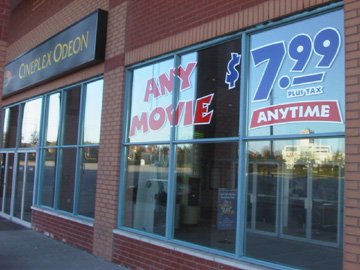
Today is like any other typical working day in our household, and one that usually begins when I drop my wife off at her office first thing in the morning. Late last week, we noticed something unusual, a throng of shabby loiterers dressed in odd costumes, aimlessly hanging around the entrance to my wife's building. Not usually something to take notice of, but in this case they also had lawn chairs and sleeping bags, and it was before 7 in the morning. Was there some kind of protest brewing? We didn't give it a second thought.
On Monday, it occurred to us that this wasn't any random gathering, in fact it was the start of a lineup for the new
Star Wars movie that debuts this Friday (my wife's office has a movie multiplex on its ground floor). The Star Wars franchise has indeed been unlike any other, as it has transcended the screen to become the basis for what can only be described as cult like behavior; line-ups such as the one I have described demonstrate the magnitude of this following's
devotion.
The question I suppose is now that George Lucas has already announced this installment will be
the last, will we ever see these kinds of lineups again? When I ponder this, I can't help but think beyond Star Wars to the bigger picture issues and wonder about the changing nature of how we go about watching films. Hollywood, we are told, is in the midst of a massive slump characterized by a marked decrease in box office receipts. Analysts could be dismissive about this and simply chalk this up to a temporary creativity deficit in Hollywood that has resulted in a spate of awful re-renderings of 60's TV shows repackaged for the screen. Once the product gets better, the crowds will come back.
Or will they? The trend in fact could be indicative of something much bigger and more significant, namely, the redundancy of movie theaters themselves. Technology it would seem is having a huge effect on the way people watch movies. DVDs, On-Demand content offered by cable and satellite providers, and sophisticated in-home audio and visual equipment (e.g. HDTV) are equalizing the playing field leaving many consumers indifferent between going out for a flick, or enjoying one at home that is increasingly providing them with a near identical experience. Faced with the choice and the prospect of shelling out a small fortune for the ticket price at a local theater (part of which goes to financing the development charges associated with the
over-building of a ton of expensive multiplex theaters in the 90’s, that were supposed to serve as the anchoring strategy for the new retail complexes of the future), more and more consumers are taking a pass on the theater option and staying at home. The result is predictable, box office
receipts are down, and theater operators are being forced to drastically reduce their prices.

The point of today’s rant? Amidst all the change that has taken place in business over the past century, what with the decline of manufacturing, the rise of knowledge work much greater participation rates of women and minorities in the mainstream workforce, and other significant factors (such as risk), the motion picture industry has remained relatively unchanged, and true to a business model that has worked for almost a hundred years. It now finds itself at a crossroads; in order to move forward, it now needs to make significant changes to that business model, mainly because the bricks and mortar are really not that an important significant consideration in the overall equation. If change of this magnitude can radically impact the movie business, we would be naïve to assume that external forces will not affect the way we conduct work, and change the bricks and mortar equation associated with workplace.




 Mother's Day is always a time to put aside issues that consume us in our day to day lives, and focus on Mom. Although I lost my mother four years ago, she is always with me. Today, I thought I would do something a little different to remember her. After she passed, I submitted a piece about her to The Globe and Mail, hoping that they would publish it. On December 21, 2001, they did, so I thought today would be a good day to republish it as my way of saying thanks to Mom.
Mother's Day is always a time to put aside issues that consume us in our day to day lives, and focus on Mom. Although I lost my mother four years ago, she is always with me. Today, I thought I would do something a little different to remember her. After she passed, I submitted a piece about her to The Globe and Mail, hoping that they would publish it. On December 21, 2001, they did, so I thought today would be a good day to republish it as my way of saying thanks to Mom.